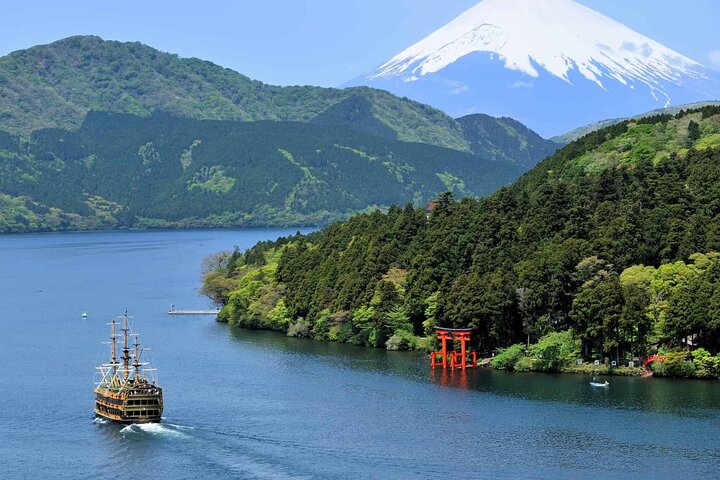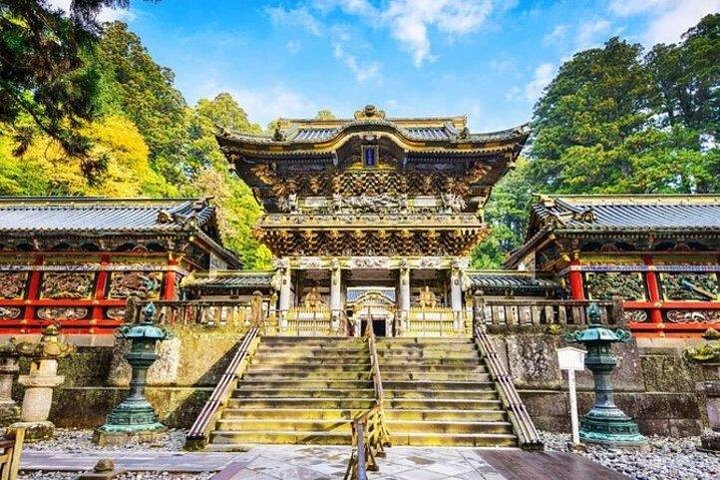Explore Hakone’s natural and artistic wonders with a private guide. Visit Owakudani, Lake Ashinoko, and more. Book your full-day tour now!
Explore Hakone’s natural and artistic wonders with a private guide. Visit Owakudani, Lake Ashinoko, and more. Book your full-day tour now!
- Lake Ashinoko - Lake Ashinoko (芦ノ湖, Ashinoko) was created in the caldera of Mount Hakone following the volcano’s last eruption 3,000 years ago. Today, the lake, with Mount Fuji in the background, serves as a symbol of Hakone. The lake’s shores remain largely undeveloped, except for small towns in the east and north and a few lakeside resort…
- Lake Ashinoko - Lake Ashinoko (芦ノ湖, Ashinoko) was created in the caldera of Mount Hakone following the volcano’s last eruption 3,000 years ago. Today, the lake, with Mount Fuji in the background, serves as a symbol of Hakone. The lake’s shores remain largely undeveloped, except for small towns in the east and north and a few lakeside resort hotels. The best views of the lake with Mount Fuji can be enjoyed from Moto-Hakone and the Hakone Detached Palace Garden.
- Hakone Shrine - Hakone-jinja Shrine is a serene place of worship with a history spanning over 12 centuries. Although its buildings have been destroyed by fire and rebuilt multiple times, the shrine and its surrounding forest maintain an atmosphere of peace and mystery.
- Pola Museum of Art - The POLA group, a skincare and beauty products company, opened the POLA Museum of Art (ポーラ美術館, Pōla Bijutsukan) in 2002 to showcase the extensive private art collection of the company’s late owner, Suzuki Tsuneshi. The museum was constructed amid a forest of 300-year-old beech trees, and although made of concrete and glass, it is designed to blend with the natural environment. Most of the building is located underground to achieve this. The museum features modern and contemporary paintings, sculptures, ceramics, and glassware by primarily Japanese and European artists. In addition to temporary exhibits, the museum displays rotating exhibits from its permanent collection, including works by artists such as Cezanne, Monet, Picasso, and Renoir.
Admission: 1800 yen (1600 yen with the Hakone Free Pass)
- Okada Museum of Art - The Okada Museum of Art is a privately-owned museum showcasing a wide collection of art pieces from antiquity to the modern era. Opened in 2013, the museum features a large array of East Asian ceramics, sculptures, and paintings, all housed in a spacious, modern facility surrounded by expansive grounds that include a Japanese garden, a teahouse, and a cafe with a hot spring foot bath. The heart of the museum’s collection lies in its vast collection of Chinese and Japanese ceramics and sculptures, which dominate the first two floors, including ancient Chinese bronzes, Tang and Ming porcelain, early Japanese pottery, and more. The upper floors focus on Japanese art, with a variety of art forms and time periods represented. Most items on display are labeled with basic information in English, Chinese, Korean, and Japanese.
- Hakone Ropeway - The Hakone Ropeway (箱根ロ-プウエイ) is part of the Hakone Round Course, a popular way to explore Hakone. It connects Sounzan Station (at the terminus of the Hakone Tozan Cablecar) with Togendai Station (at the shore of Lake Ashinoko) and stops at Owakudani and Ubako stations along the way. The ropeway is fully covered by the Hakone Free Pass. The ropeway’s gondolas depart every minute and accommodate around ten people each. Traveling the full length of the ropeway takes about 30 minutes. Along the journey, passengers can enjoy views of the active, sulfuric hot spring sources of the Owakudani Valley between Sounzan and Owakudani and of Lake Ashinoko and Mount Fuji between Owakudani and Togendai, if visibility allows. A transfer of gondolas is necessary at Owakudani, but no transfer is needed at Ubako.
Admission: 1480 yen (one way), covered by the Hakone Free Pass
- Sengokuhara - A beautiful slope of Pampas grass that is most stunning in the fall.
- Hakone Venetian Glass Museum - The Hakone Glass no Mori (箱根ガラスの森) features Italian-styled buildings housing a museum and shops. Outside is a large strolling garden surrounding a canal-like pond. The garden has several large glass sculptures, as well as a cafe with an open terrace at one end where live canzoni (Italian ballads) performances are held. The Glass no Mori’s Venetian Glass Museum houses a collection of over 100 pieces of Venetian glassware. It displays both modern and classical works in all forms, including vases, goblets, lamps, and sculptures. The Hakone Glass no Mori is operated by the Ukai Group, an operator of themed high-class restaurants, which also owns the Kawaguchiko Music Forest at Kawaguchiko in the Fuji Five Lakes region.
Admission: 1500 yen (1400 yen with the Hakone Free Pass)
- Hakone Museum of Art - The Hakone Museum of Art (箱根美術館, Hakone Bijutsukan), located in Gora, was founded by Okada Mokichi in 1952. Its sister museum, the MOA Museum of Art, was later built in Atami City on the Izu Peninsula. The museum displays mainly Japanese ceramics from prehistoric times through the Edo Period (1600-1868). These include a number of large earthenware and ceramic vessels, such as a haniwa burial statue classified as an Important Cultural Property.
Admission: 900 yen (700 yen with the Hakone Free Pass)
- Choanji Temple - Choanji Temple (長安寺, Chōanji) is a temple of the Soto school of Zen Buddhism in the Sengokuhara area of Hakone. Established in 1356 in a quiet area at the base of a hill, the atmospheric temple has a small network of pleasant walking trails that wind through its wooded grounds and cemetery. What lends Choanji its particular charm, however, are the over two hundred statues of rakan (disciples of Buddha) scattered around the temple grounds. The statues began appearing in the 1980s and have been accruing ever since. Each statue has a unique face and shape, some contemplative and serious, others casual and humorous, and many show a modern edge in their artistic style and expressiveness compared to other collections of rakan statues. In autumn, the temple grounds are also one of Hakone’s nicer spots to enjoy the autumn colors. The many color-changing trees here usually reach their peak color around mid-November.
- Hakone Shisseikaen - The Hakone Botanical Garden of Wetlands (箱根湿生花園, Hakone Shisseikaen) is a botanical garden in the highlands of Fuji Hakone Izu National Park. The park was founded in 1976 as a place to preserve and exhibit over 1,700 varieties of marsh and alpine plants native to Japan. The garden offers a network of boardwalk paths through different types of marshland where visitors can learn about the plants that populate the wetlands. Information signs are in English and Japanese. The garden is popular during June when its Nikko Kisuge (daylily) are in full bloom, however, it is closed during the winter months.
Admission: 700 yen (600 yen with the Hakone Free Pass)
- Gora Park - Gora Park (強羅公園, Gōra Kōen) is a western-style landscape park located on the steep slope above Gora Station. It is a relaxing place to unwind and enjoy the scenery and views of Hakone. Gora Park is primarily a French-styled landscape park featuring a large fountain and a rose garden. The park also has two greenhouses, one housing a tropical botanical garden while the other contains a flower garden. Additionally, there is a restaurant overlooking the main fountain, as well as the Hakuun-do Chaen teahouse. In the Crafthouse, visitors can take part in craft activities such as glass blowing, glass etching, pottery, and dried flower arrangement. Activities range in cost from 1000 to 5000 yen and take from 30 minutes to an hour to complete.
Admission: 550 yen (free with the Hakone Free Pass)
- The Hakone Open-Air Museum - The Hakone Open-Air Museum is the first open-air art museum in Japan, built in Hakone with the aim of harmonizing nature and art. Artworks are placed throughout the vast site of about 70,000 square meters, surrounded by beautiful trees, grass, and mountains. It can be enjoyed by a wide range of ages, from families with children to adults traveling alone.
- Owaku-dani Valley - Owaku-dani is an active volcano that powers the hot springs in the local area. Take the ropeway over the volcano to the observatory to learn about this important volcano and try one of the black boiled eggs said to bring long life!
- Dollhouse Museum Hakone - A quaint museum that houses a collection of dollhouses from around the world, some over 200 years old. The museum holds different dollhouse exhibits year-round, so be sure to check what will be available to see! A great place for lovers of miniatures.
- Narukawa Art Museum - The Narukawa Museum of Art (成川美術館, Narukawa Bijutsukan) is a contemporary art museum dedicated to a style of painting known as nihonga. Literally meaning “Japanese-style painting”, nihonga are paintings that adhere to traditional Japanese artistic conventions, techniques, tools, and materials. The label was originally meant to simply distinguish the art from Western-style paintings, but artists have since expanded the scope of nihonga to also include Western techniques. Besides the art collection, the museum features an impressive panorama lounge and cafe with large windows overlooking Lake Ashinoko. On a clear day, it affords one of the best views of Mount Fuji, the lake, and the floating torii gate of Hakone Shrine.
Admission: 1300 yen (1100 yen with Hakone Free Pass or online coupon)
- Kamiyama Mountain Climbing Course - The Owakudani Nature Study Path is a special walking trail through an active volcanic area. It offers close-up views of Hakone’s geothermal activity. Advance reservation is required and the entrance fee is 800 yen.

- Private vehicle
- Customizable Tour of your choice of 3-4 sites from ‘What to expect’ list
- Licensed Local English Speaking Guide
- Private vehicle
- Customizable Tour of your choice of 3-4 sites from ‘What to expect’ list
- Licensed Local English Speaking Guide
- Entrance fees, Lunch, and Other personal expenses
- You cannot combine multiple tour groups.
- Guide Entry fees are only covered for sights listed under What to Expect.
- Hakone Freepass
- Entrance fees, Lunch, and Other personal expenses
- You cannot combine multiple tour groups.
- Guide Entry fees are only covered for sights listed under What to Expect.
- Hakone Freepass
This tour is perfect for those eager to explore Hakone’s main attractions efficiently in a private vehicle, guided by a government-licensed and experienced English-speaking guide! Join the journey to the stunning mountain resort town of Hakone. Set amidst the mountains, Hakone is a hub of natural and artistic marvels. Visit Owakudani to witness the…
This tour is perfect for those eager to explore Hakone’s main attractions efficiently in a private vehicle, guided by a government-licensed and experienced English-speaking guide! Join the journey to the stunning mountain resort town of Hakone. Set amidst the mountains, Hakone is a hub of natural and artistic marvels. Visit Owakudani to witness the continuous sulfurous gases from the active volcano that heats the numerous nearby hot springs. Sample the region’s renowned black-boiled eggs, which turn black and absorb minerals from the spring. Take the ropeway down the mountain to Lake Ashinoko for a breathtaking view of Mount Fuji. Cruise across the lake to see the Torii gate by the Kuzuryu shrine, dedicated to the area’s 9-headed dragon deity. Art enthusiasts can enjoy visiting one of Hakone’s many art museums.
- There are only a limited number of car seats and booster seats. Rear-facing car seats are not available. You must contact us directly if you need them.
For a full refund, cancel at least 24 hours before the scheduled departure time.
For a full refund, cancel at least 24 hours before the scheduled departure time.























